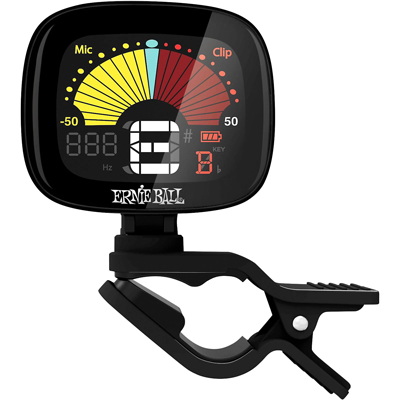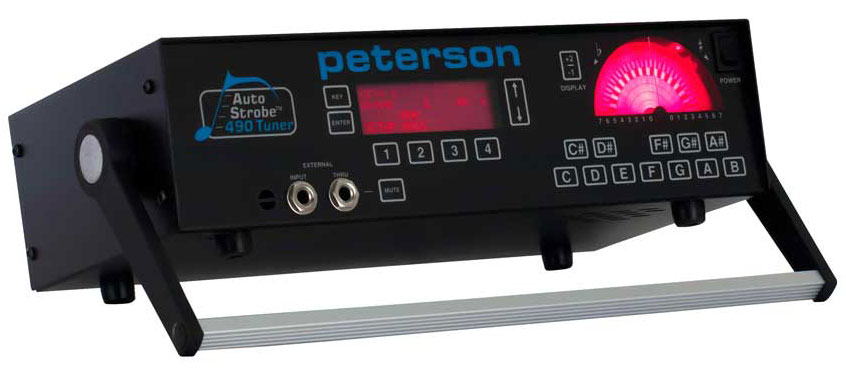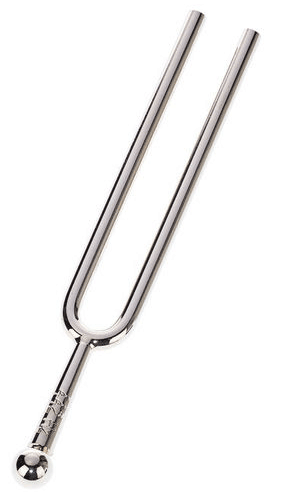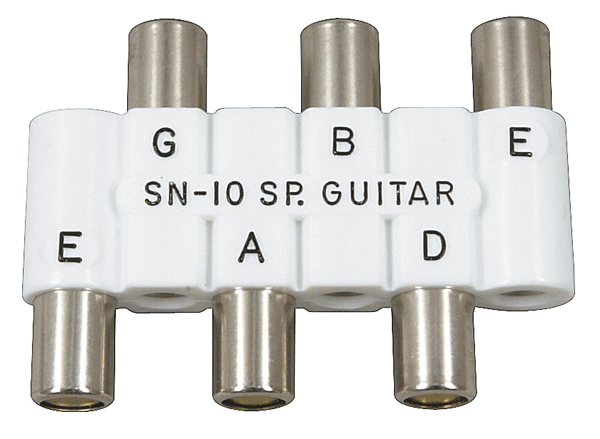The easiest way for a beginner to keep a guitar in tune is to use an inexpensive clip-on tuner. In this video, I show you how to use an electronic tuner, using a clip-on tuner as an example. Because all electronic tuners function in the same basic way, the process shown in the video will work for any tuner.
Types of Electronic Tuners
Electronic tuners come in different forms, from simple and inexpensive, to feature-laden and expensive. The main types of electronic tuners are clip-on, pedal, rack-mount, and software.
Clip-On Tuners
Probably the most common type of electronic tuner found these days is the clip-on tuner. These devices clip onto the headstock of the guitar and sense the frequency of the played note via vibrations along the neck into the headstock.
It’s hard to beat the convenience of a clip-on tuner: it easily attaches to your guitar, works even in a noisy room, and can be used with both acoustic and electric guitars.
Generally speaking, you’re not going to get the absolute peak of accuracy with a clip-on tuner, but that’s usually not necessary for everyday playing. If you’re going to be playing a live show or recording, it might be better to use a pedal or a rackmount unit.
Tuner Pedals
Tuner pedals, like the classic Boss TU-3 shown here, are a staple for any guitarist that plays live gigs. They’re usually placed either first or last in the signal chain and provide a very convenient way of tuning up during a performance. With a pedal, you can quickly mute your guitar while tuning so the audience doesn’t have to listen to you tune.
Additionally, buffered pedals (like the TU-3) provide an internal buffer that slightly boosts the signal, allowing you to run longer lengths of cable without experiencing the signal loss that would otherwise occur.
Rackmount Tuners
Rackmount tuners are typically found in professional and home recording studios, and as part of on-stage effects racks. They tend to be pricier than the other options but can sometimes provide greater accuracy and are usually easier to see from a distance. The rack-mount form factor of these tuners is really only practical if you already use a rack for effects or an amp; otherwise, a pedal is more convenient.
Software Tuners
Software tuners usually come bundled with audio recording software, like Logic Pro or Reaper, or guitar effect software, like Amplitube or Bias FX. Since your guitar is already plugged into an audio interface when using these programs, built-in tuners provide an easy way to tune up within the software itself.
In addition to tuners that are already included with other software packages, third-party plugins are also available, like the popular (and free) GTune, shown here.
Other Ways to Tune
We’ve looked at the most commonly used methods of tuning the guitar, but there are plenty of other options as well. For situations that require the highest accuracy possible—such as a guitar technician or luthier adjusting the intonation on a guitar—an analog strobe tuner is the most accurate (and expensive) option.
True strobe tuners can provide accuracy many times greater than electronic tuners, however this is not always necessary or desirable for playing purposes. Also, analog strobe tuners use a mechanical tuning mechanism that’s more delicate than an electronic circuit, so they’re not well-suited to the rigors of being hauled from gig to gig.
For those who know how to tune by ear, a simple tuning fork is a convenient way of getting a specific reference note that can be used to tune one string of the guitar. The rest of the strings are then tuned to that string. Most tuning forks used for musical applications ring out at the pitch A-440—an A note that resonates at 440 cycles per second. Because tuning forks are small and sturdy, they’re convenient to have on hand, tucked away in a guitar case or gig bag, in case you find yourself without your trusty clip-on or pedal tuner.
Conclusion
Being able to tune your guitar is an invaluable skill for any guitarist, and there are many devices available to help you do that. For beginners, a good first step is learning how to correctly use an electronic tuner, as shown in the video above. Once you’ve mastered this, the next step is learning how to tune one string to a reference note, and then tuning the rest of the guitar to itself. I’ll cover that in a separate lesson, so stay tuned.







